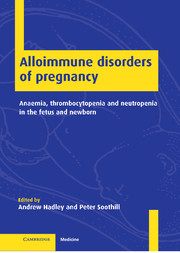 Alloimmune Disorders of Pregnancy
Alloimmune Disorders of Pregnancy Book contents
- Frontmatter
- Contents
- List of contributors
- Preface
- Foreword
- List of abbreviations
- 1 Pathophysiology of the alloimmune cytopenias
- 2 Blood group antibodies in haemolytic disease of the fetus and newborn
- 3 Basis and practice of screening for haemolytic disease of the fetus and newborn
- 4 Epidemiology and screening for alloimmune thrombocytopenia
- 5 Principles of antibody-mediated immune suppression and the prevention of maternal RhD alloimmunization
- 6 The clinical application of anti-D prophylaxis
- 7 Fetal genotyping
- 8 Laboratory assays to determine the severity of haemolytic disease of the fetus and newborn
- 9 Assessing the severity of haemolytic disease of the fetus and newborn: clinical aspects
- 10 Antenatal therapy for haemolytic disease of the fetus and newborn
- 11 Neonatal therapy for haemolytic disease of the newborn
- 12 The diagnosis of alloimmune thrombocytopenia
- 13 The immunological diagnosis of alloimmune neutropenia
- 14 Fetal and neonatal treatment of alloimmune thrombocytopenia
- Index
2 - Blood group antibodies in haemolytic disease of the fetus and newborn
Published online by Cambridge University Press: 26 October 2009
- Frontmatter
- Contents
- List of contributors
- Preface
- Foreword
- List of abbreviations
- 1 Pathophysiology of the alloimmune cytopenias
- 2 Blood group antibodies in haemolytic disease of the fetus and newborn
- 3 Basis and practice of screening for haemolytic disease of the fetus and newborn
- 4 Epidemiology and screening for alloimmune thrombocytopenia
- 5 Principles of antibody-mediated immune suppression and the prevention of maternal RhD alloimmunization
- 6 The clinical application of anti-D prophylaxis
- 7 Fetal genotyping
- 8 Laboratory assays to determine the severity of haemolytic disease of the fetus and newborn
- 9 Assessing the severity of haemolytic disease of the fetus and newborn: clinical aspects
- 10 Antenatal therapy for haemolytic disease of the fetus and newborn
- 11 Neonatal therapy for haemolytic disease of the newborn
- 12 The diagnosis of alloimmune thrombocytopenia
- 13 The immunological diagnosis of alloimmune neutropenia
- 14 Fetal and neonatal treatment of alloimmune thrombocytopenia
- Index
Summary
Human blood groups were discovered in 1900, but the first suspicion that a woman might be immunized by alloantigens on the red cells of her fetus did not appear until 1939, with the discovery of the Rh D antigen. In 1941, Levine et al. showed that blood groups were responsible for a disease associated with stillbirth, hydrops, jaundice and kernicterus. That disease was named erythroblastosis fetalis, although a more appropriate title is haemolytic disease of the fetus and newborn (HDFN).
HDFN is caused by the immune destruction of fetal red cells or their progenitors, facilitated by maternal antibodies. In order for the mother to produce an alloantibody, her red cells must lack the culpable antigen, which the fetus must have inherited from its father. Red cell antigen polymorphism, therefore, is at the root of HDFN. Over 250 well-established blood group specificities have been identified, but only a minority of these have been implicated in clinically severe HDFN.
The severity of HDFN varies enormously. At its most extreme, it culminates in fetal or neonatal death, yet in many publications antibodies have been reported to have caused HDFN when the indications have been no more than a positive direct antiglobulin test result with fetal red cells. In this chapter, HDFN will generally only be considered to have occurred when clinical intervention in excess of phototherapy for jaundice, such as intrauterine or neonatal transfusion, was indicated, or when kernicterus or hydrops was reported.
- Type
- Chapter
- Information
- Alloimmune Disorders of PregnancyAnaemia, Thrombocytopenia and Neutropenia in the Fetus and Newborn, pp. 21 - 40Publisher: Cambridge University PressPrint publication year: 2001
- 1
- Cited by


